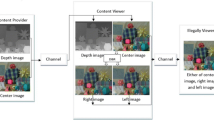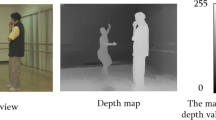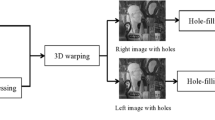Abstract
Depth image based rendering (DIBR) is a promising technique for extending viewpoints with a monoscopic center image and its associated per-pixel depth map. With its numerous advantages including low-cost bandwidth, 2D-to-3D compatibility and adjustment of depth condition, DIBR has received much attention in the 3D research community. In the case of a DIBR-based broadcasting system, a malicious adversary can illegally distribute both a center view and synthesized virtual views as 2D and 3D content, respectively. To deal with the issue of copyright protection for DIBR 3D Images, we propose a scale invariant feature transform (SIFT) features based blind watermarking algorithm. To design the proposed method robust against synchronization attacks from DIBR operation, we exploited the parameters of the SIFT features: the location, scale and orientation. Because the DIBR operation is a type of translation transform, the proposed method uses high similarity between the SIFT parameters extracted from a synthesized virtual view and center view images. To enhance the capacity and security, we propose an orientation of keypoints based watermark pattern selection method. In addition, we use the spread spectrum technique for watermark embedding and perceptual masking taking into consideration the imperceptibility. Finally, the effectiveness of the presented method was experimentally verified by comparing with other previous schemes. The experimental results show that the proposed method is robust against synchronization attacks from DIBR operation. Furthermore, the proposed method is robust against signal distortions and typical attacks from geometric distortions such as translation and cropping.




















Similar content being viewed by others
References
Amerini I, Ballan L, Caldelli R, Del Bimbo A, Serra G (2011) A sift-based forensic method for copy–move attack detection and transformation recovery. IEEE Trans Inf Forensics Secur 6(3):1099–1110
ASSEMBLY, ITU Radiocommunication (2003) Methodology for the subjective assessment of the quality of television pictures. International Telecommunication Union
Barni M, Bartolini F, Cappellini V, Piva A (1998) A DCT-domain system for robust image watermarking. Signal Process 66(3):357–372
Cui, Chen, Shen W et al (2017) "A novel watermarking for DIBR 3D images with geometric rectification based on feature points." Multimedia Tools and Applications 76.1: 649–677
Fehn C (2004, May) Depth-image-based rendering (DIBR), compression, and transmission for a new approach on 3D-TV. In Electronic Imaging 2004, International Society for Optics and Photonics, pp 93–104
Fehn C, De La Barré R, Pastoor S (2006) Interactive 3-DTV-concepts and key technologies. Proc IEEE 94(3):524–538
Feng X, Zhang W, Liu Y (2014) Double watermarks of 3D mesh model based on feature segmentation and redundancy information. Multimedia tools and applications 68(3):497–515
Halici E, Alatan AA (2009, November) Watermarking for depth-image-based rendering. In 2009 16th IEEE International Conference on Image Processing (ICIP), IEEE, pp 4217–4220
Hirschmuller H, Scharstein D (2007, June) Evaluation of cost functions for stereo matching. In 2007 I.E. Conference on Computer Vision and Pattern Recognition, IEEE, pp 1–8
Hou JU, Park JS, Kim DG, Nam SH, Lee HK (2014, June) Robust video watermarking for MPEG compression and DA-AD conversion. In Proceedings of the 1st international workshop on Information hiding and its criteria for evaluation, ACM, pp 2–8
Kim HD, Lee JW, Oh TW, Lee HK (2012) Robust DT-CWT watermarking for DIBR 3D images. IEEE Trans Broadcast 58(4):533–543
Lee PJ (2011) Nongeometric distortion smoothing approach for depth map preprocessing. IEEE Transactions on Multimedia 13(2):246–254
Lee HY, Kim H, Lee HK (2006) Robust image watermarking using local invariant features. Opt Eng 45(3):037002–037002
Lee MJ, Lee JW, Lee HK (2011, October) Perceptual watermarking for 3D stereoscopic video using depth information. In Intelligent Information Hiding and Multimedia Signal Processing (IIH-MSP), 2011 Seventh International Conference on, IEEE, pp 81–84
Lee JW, Kim HD, Choi HY, Choi SH, Lee HK (2012, February) Stereoscopic watermarking by horizontal noise mean shifting. In IS&T/SPIE Electronic Imaging, International Society for Optics and Photonics, pp 830307–830307
Lin YH, Wu JL (2011) A digital blind watermarking for depth-image-based rendering 3D images. IEEE Trans Broadcast 57(2):602–611
Lindeberg T (1994) Scale-space theory: a basic tool for analyzing structures at different scales. J Appl Stat 21(1–2):225–270
Lowe DG (2004) Distinctive image features from scale-invariant keypoints. Int J Comput Vis 60(2):91–110
Miao H, Lin YH, Wu JL (2014, October) Image descriptor based digital semi-blind watermarking for DIBR 3D images. In International Workshop on Digital Watermarking, Springer International Publishing, pp 90–104
Mikolajczyk K, Schmid C (2002) An affine invariant interest point detector. In Proceedings of the 7th European Conference on Computer Vision-Part I (ECCV '02), pp 128–142
Scharstein D, Pal C (2007, June) Learning conditional random fields for stereo. In 2007 I.E. Conference on Computer Vision and Pattern Recognition, IEEE, pp 1–8
Scharstein D, Szeliski R (2003, June) High-accuracy stereo depth maps using structured light. In Computer Vision and Pattern Recognition, 2003. Proceedings. 2003 I.E. Computer Society Conference on Vol. 1, IEEE, pp I–195
Scharstein D, Szeliski R, & Zabih, R (2001). A taxonomy and evaluation of dense two-frame stereo correspondence algorithms. In Stereo and Multi-Baseline Vision, 2001.(SMBV 2001). Proceedings. IEEE Workshop on (pp. 131–140). IEEE.
Petitcolas FA, Anderson RJ, & M. G. Kuhn, (1998) “Attacks on copyright marking systems,” in International workshop on information hiding. Springer, pp. 218–238
Vinukonda P (2011) A study of the scale-invariant feature transform on a parallel pipeline. Diss. Louisiana State University
Voloshynovskiy S, Herrigel A, Baumgaertner N, Pun T (1999, September) A stochastic approach to content adaptive digital image watermarking. In International Workshop on Information Hiding, Springer Berlin, Heidelberg, pp 211–236
Wang S, Cui C, Niu X (2014) Watermarking for DIBR 3D images based on SIFT feature points. Measurement 48:54–62
Zhang L, Tam WJ (2005) Stereoscopic image generation based on depth images for 3D TV. IEEE Trans Broadcast 51(2):191–199
Zitnick CL, Kang SB, Uyttendaele M, Winder S, Szeliski R (2004, August) High-quality video view interpolation using a layered representation. In ACM Transactions on Graphics (TOG) Vol. 23, No. 3, ACM, pp 600–608
Acknowledgments
This research project was supported by Ministry of Culture, Sports and Tourism(MCST) and from Korea Copyright Commission in 2017.
Author information
Authors and Affiliations
Corresponding author
Rights and permissions
About this article
Cite this article
Nam, SH., Kim, WH., Mun, SM. et al. A SIFT features based blind watermarking for DIBR 3D images. Multimed Tools Appl 77, 7811–7850 (2018). https://doi.org/10.1007/s11042-017-4678-x
Received:
Revised:
Accepted:
Published:
Issue Date:
DOI: https://doi.org/10.1007/s11042-017-4678-x




